

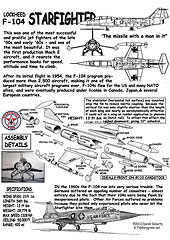
Lockheed F-104 Starfighter - $$14.95
The Lockheed F-104 Starfighter was an American single-engined, high-performance, supersonic interceptor aircraft that served with the United States Air Force (USAF) from 1958 until 1967. One of the Century Series of aircraft, it continued in service with Air National Guard units until it was phased out in 1975. The National Aeronautics and Space Administration (NASA) flew a small mixed fleet of F-104 types in supersonic flight tests and spaceflight programs until they were retired in 1994. 7 versions as of Aug/2012
Lockheed F-104 Starfighter
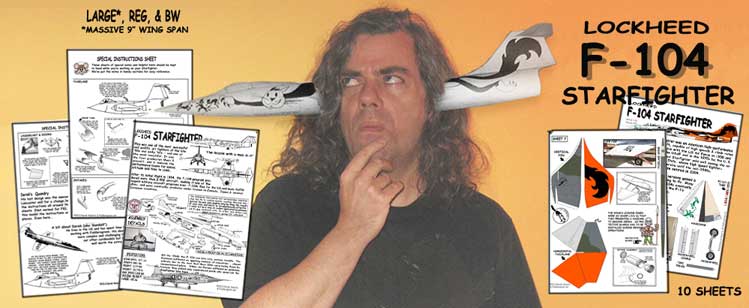
All these versions have been added to the F-104 Starfighter folder, so if you have Magic Keys on the day it gets released, or have bought the kit, they're free !!

Traditional USAF markings (above) for the Lockheed F-104 Starfighter. USAF F-104s were originally
left in bare metal finish. However, deployment to Southeast Asia led to the adoption of a three-tone.
tactical camouflage. (this version coming soon)

The Italian-cat version.. What else would Derek (the designer and cat lover) have chosen :))
 F-104 Starfighter German version |
x 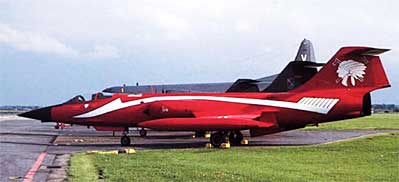 F-104 Starfighter Canadian version |
 F-104 Starfighter Bavarian version |
Lockheed F-104 Starfighter
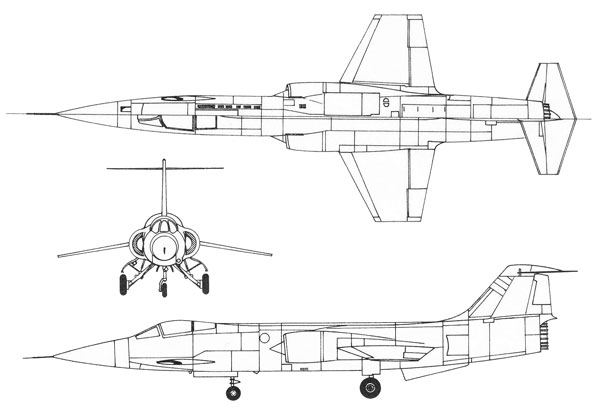 |
Following the discovery of the German research data on swept-wings after World War II, a sharply raked wing became the rule for high speed fighters. In contrast to this trend, Lockheed engineers designed a straight, but razor thin, lifting surface for their first supersonic fighter. Design studies began in November 1952; and in March 1953, two examples were ordered as XF-104's. When it made its appearance, the first prototype bore a strong resemblance to a Lockheed-designed research missile, the X-7. In fact, the XF-104 owed a great deal of its design to the X-7 vehicle. The first flight took place on February 2, 1954, and the test program was conducted with a second XF-104 and 15 YF-104A's. The XF-104's were powered by afterburning Wright J65-W-6 engines.
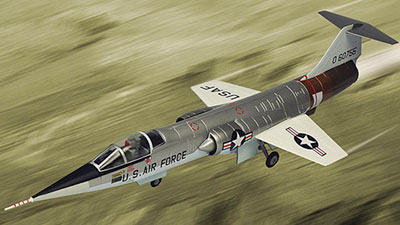 |
This image gleaned from the 'net looks suspiciously like a well put together plastic model with a Photo-shopped blurred background |
When delivery began on the YF-104A's, by then known as Starfighters, the powerplant was a General Electric J79-GE-3 with an afterburning power of 14,800 pounds. This engine provided fifty percent more thrust than the J65. Another item added to the YF-104's, and retained in production models, was a shock-control cone on the air inlet to position the supersonic shock wave inside the duct. The overall length was increased from 49 feet to 54 feet 9 inches to house the new engine.
Shortly after production of 155 F-104A's had started, the planes were fitted with a ventral fin and arresting hook. Before deliveries of the Starfighter could begin, unexpected problems arose which required an intensive test program. Among these was the tendency of the aircraft to stabilize in a stalled condition-now called super stall. In this condition, the plane remains pitched up in a stalled attitude from which recovery is impossible. This flaw was corrected in April 1957. The tip-mounted fuel tanks were subject to modifications to eliminate a tendency to slam into the fuselage upon ejection. Finally, the sleek fighter was released for service, and the 83rd Fighter Wing received its first Starfighters on January 26, 1958. Within three months, the new planes were grounded due to engine failures. This was overcome by replacement with an improved J79-GE-38, but the F-104A continued to be subject to a high accident rate. Suffering, also, from relatively short- range and without all weather capabilities, the Air Force was compelled to withdraw the planes from first-line service.
Many were sold to foreign countries, the remainder finding their way into the ranks of the Air National Guard. Others became QF- 104A target drones, and three were equipped with 6,000 lb. thrust Rocketdyne AR-2 booster rockets for use by the Aerospace Research Pilot's School.
The F-104C was Lockheed's answer to the shortcomings of the "A" model. Seventy seven of the improved Starfighters were delivered, the first of them arriving at a TAC squadron on October 16, 1958. This model was operated only by the 479th Tactical Fighter Wing before retirement. The escape system used on the F-104A and "C" was of the downward ejection type.
The value of this method of ejection at low level is questionable, at best. The F-104B is a tandem-seat trainer version of the Starfighter. The second seat was located in the area occupied by electronics, armament and one of the fuselage tanks. Twenty-six F-1048's were assembled.
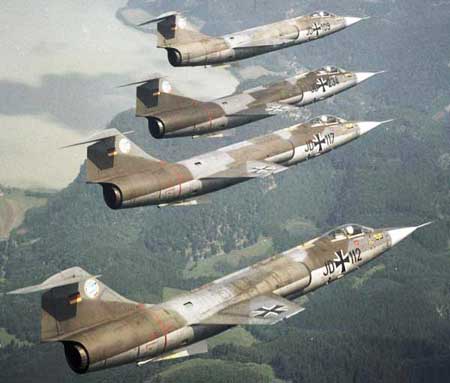 |
| Despite fundamental unsuitability for tactical strike, the Starfighter became the subject of an immense multinational manufacturing program (as the F-104G), being built in Europe, Canada (as the CF-104) and Japan (in the F-104J dedicated interceptor variant). The final model, the F-104S developed jointly by Lockheed and Aeritalia, was first flown in 1966, having a 17,900 lb J79-GE-19 engine, additional stores pylons, provision for AIM-7 Sparrow III air-to-air missiles and a maximum weight of 31,000 lb. The production of 205 aircraft was completed in Italy in the latter part of 1978. This brought the overall total of Starfighters built to 2,536, of which 737 were built by Lockheed. |
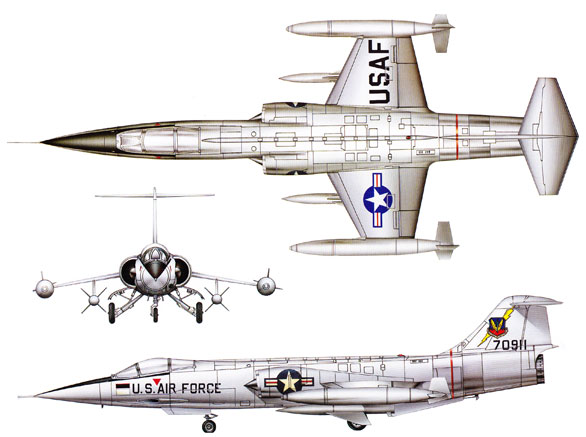 |
Although the Starfighter was not an outstanding success with the U. S. Air Force, the vastly improved export F-104G/J has more than proven the soundness of its design. This model has been built under license in Japan, Germany, Netherlands, Canada, Belgium and Italy.
|
Despite its initial difficulties, the Starfighter has proven to be an exceptional performer. It was the first operational combat plane to be able to sustain Mach 2 speeds.This speed was first reached on April 27,1955. The F-104 was also the first plane to hold both speed and altitude records simultaneously, reaching a height of 91,243 feet on May 8, 1958, and a speed of 1,404.19 mph eight days later. The following year, an F-104 climbed to 103,396 feet.
The F-104's exceptionally-thin wing is so sharp, a felt cap is placed over it to protect the ground crew during servicing. The wingspan is 21 feet 11 inches. Length is 54 feet 9 inches, height is 13 feet 6 inches. Wing area is 179 square feet. Gross weight is 23,590 pounds, including 900 gallons of fuel in fuselage tanks, 390 gallons in two underwing tanks, and 340 gallons in two tip tanks. The F-104C can be refueled in flight. Maximum speed is 1,450 mph at 40,000 feet. Service ceiling is 58,000 feet. A General Electric M61 Vulcan 20 mm rotary cannon, firing 6,000 rounds per minute, is mounted in the left side of the fuselage. Additional armament in the form of four Sidewinder heat-seeking missiles can be attached to the wings.
Lockheed F-104 Starfighter
With its genesis in the Korean War, the Starfighter was first of the bi-sonic fighters generated by experience of that conflict. Original in concept, it represented a radical
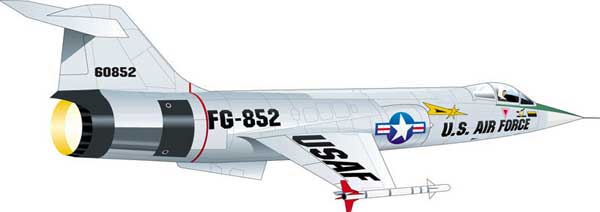 |
The Lockheed F-104 Starfighter was an American single-engined, high-performance, supersonic interceptor aircraft that served with the United States Air Force (USAF) from 1958 until 1967. One of the Century Series of aircraft, it continued in service with Air National Guard units until it was phased out in 1975. The National Aeronautics and Space Administration (NASA) flew a small mixed fleet of F-104 types in supersonic flight tests and space flight programs until they were retired in 1994. |
advance in the state of the art and few aircraft have had greater impact on fighter technology. Conceived by Clarence Johnson purely as a high-altitude air superiority fighter, the Starfighter was to undergo an extraordinary metamorphosis for multi-role operation, being entirely restressed to meet new strength requirements with full external loads and to permit low-altitude missions without restrictions.
In the process, it was to become one of the most controversial war-planes ever manufactured in quantity. First flown (as the XF-104) on 7
February 1954, the Starfighter was characterized by a diminutive unswept wing of thin (3-4 per cent) thickness-chord ratio mounted immoderately far aft on an inordinately long, slim fuselage.
Penalties were to be paid for its role transformation, wing loading increasing from the 96 lb/sq ft of the clean F-104A interceptor to no less than 158 lb/ sq ft for the ultimate multi-role derivative, the F-104S, in fully laden condition.
USAF F-104Cs saw service during the Vietnam War, and F-104A aircraft were deployed by Pakistan briefly during the Indo-Pakistani wars. Republic of China Air Force F-104s also engaged the People's Liberation Army Air Force over the disputed island of Kinmen. A set of modifications produced the F-104G model, which won a NATO competition for a new fighter-bomber.
The ultimate F-104 version was the F-104S all-weather interceptor equipped with radar-guided AIM-7 Sparrow missiles, designed for the Italian Air Force. An advanced F-104 with a high-mounted wing, known as the CL-1200 Lancer, did not proceed. The project was cancelled at the mock-up stage in favor of other lightweight fighters such as the F-16. A total of 2,535 Starfighters were eventually produced. The F-104 served with the air forces of over a dozen nations until the summer of 2004, some 46 years after its introduction in 1958 by the USAF.
Operational history
USAF Air Defense Command
The F-104A initially served briefly with the USAF Air Defense Command / Aerospace Defense Command (ADC) as an interceptor, although neither its range nor armament were well-suited for that role. The first unit to become operational with the F-104A was the 83rd Fighter Interceptor Squadron on 20 February 1958, at Hamilton AFB, California. After just three months of service, the unit was grounded after a series of engine-related accidents. The aircraft were then fitted with the J79-3B engine and another three ADC units equipped with the F-104A. The USAF reduced their orders from 722 Starfighters to 155. After only one year of service these aircraft were handed over to ADC-gained units of the Air National Guard, although it should be noted that the F-104 was intended as an interim solution while the ADC waited for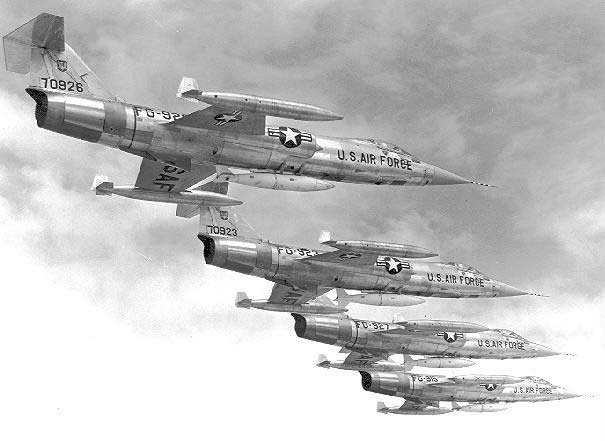 delivery of the F-106 Delta Dart.
delivery of the F-106 Delta Dart.
USAF Tactical Air Command
The subsequent F-104C entered service with Tactical Air Command as a multi-role fighter and fighter-bomber. The 479th Tactical Fighter Wing at George AFB, California, was the first unit to equip with the type in September 1958. Although not an optimum platform for the theater, the F-104 did see limited service in the Vietnam War. Again, in 1967, these TAC aircraft were transferred to the Air National Guard.
Vietnam War
Commencing with the Operation Rolling Thunder campaign, the Starfighter was used both in the air-superiority role and in the air support mission; although it saw little aerial combat and scored no air-to-air kills, Starfighters were successful in deterring MiG interceptors. Starfighter squadrons made two deployments to Vietnam, the first being from April 1965 to November 1965, flying 2,937 combat sorties. During that first deployment, two Starfighters were shot down by ground fire. One was shot down by a Chinese MiG-19 (Shenyang J-6) when the F-104 strayed over the border, and two F-104s were lost to a mid-air collision associated with that air-to-air battle.
The last use of the Starfighter in US markings was training German pilots for the Luftwaffe, with a wing of TF-104Gs and F-104Gs based at Luke Air Force Base, Arizona. Although operated in USAF markings, these aircraft (which included German-built aircraft) were owned by Germany. They continued in use until 1983.
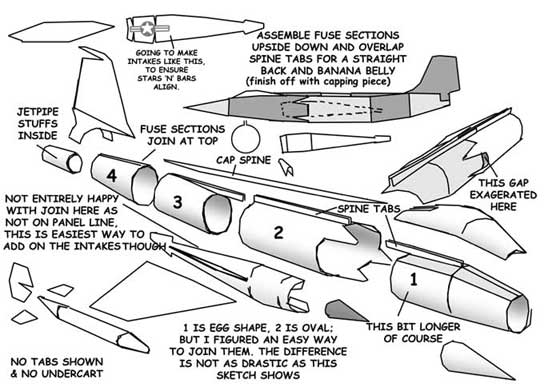 A sketch of the basic parts layout |
 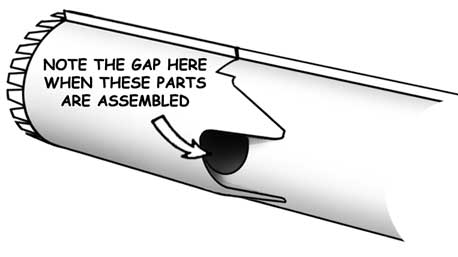 |
 Some of Derek's progress reports for his F-104 Starfighter |
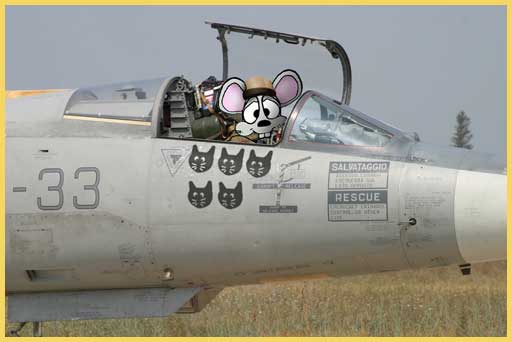 Starfighter's mascot |
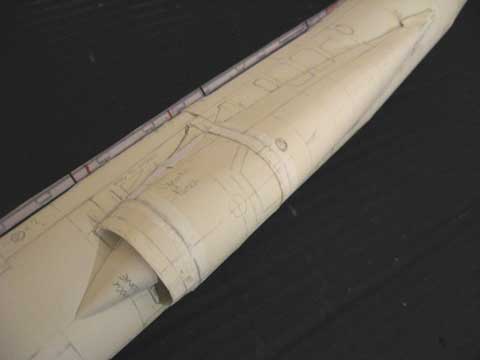 Early phgoto of the model F-104 intake system |
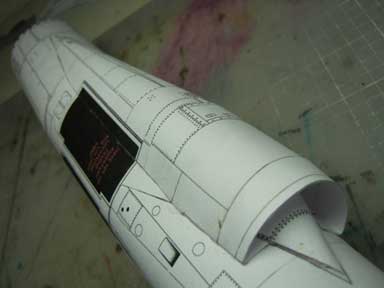 The F-104 intake system |
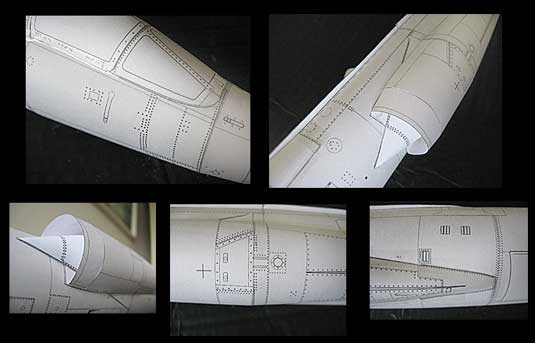 Starfighter coming along- May 12, 2012 |
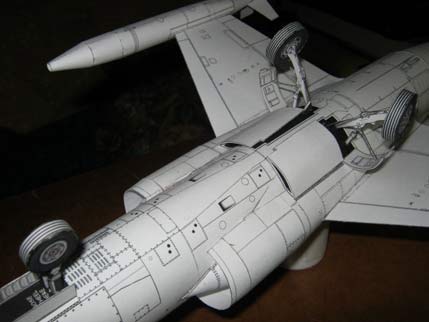 Final Beta build of the F-104 landing gear configuration |
Specifications Lockheed F-104G Starfighter
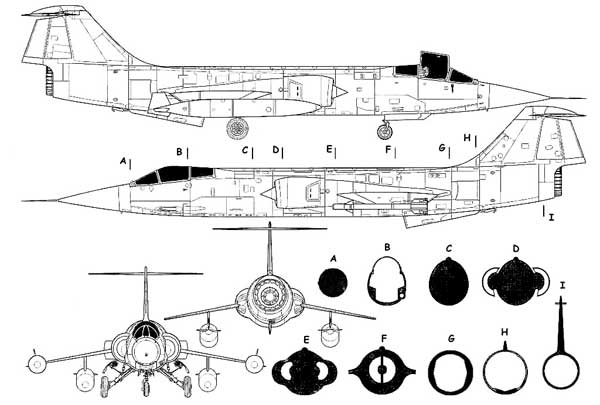 |
Length: 54 ft 8 in Wingspan: 21 ft 9 in Height: 13 ft 6 in Wing area: 196.1 ft² Empty weight: 14,000 lb Loaded weight: 20,640 lb Max takeoff weight: 29,027 lb Powerplant: 1× General Electric J79-GE-11A afterburning turbojet Dry thrust: 10,000 lbf Thrust with afterburner: 15,600 lbf Aspect ratio: 2.45 |
|
Armament 1 × 20 mm (0.79 in) M61 Vulcan gatling gun, 725 rounds Hardpoints: 7 with a capacity of 4,000 lb,with provisions to carry combinations of: Missiles: 4 × AIM-9 Sidewinder |
Performance Maximum speed: 1,328 mph Combat radius: 420 mi Ferry range: 1,630 mi Service ceiling: 50,000 ft Rate of climb: 48,000 ft/min Wing loading: 105 lb/ft² |
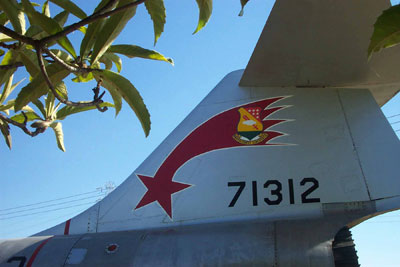 F-104 Starfighter at the Castle Museum-all 4 photos |
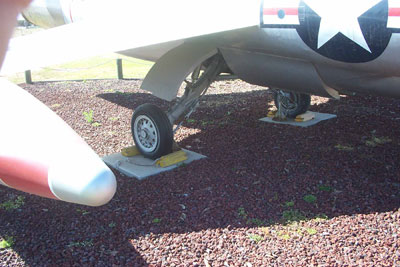 |
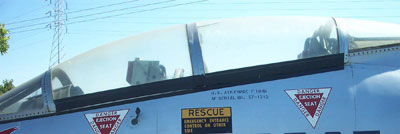 |
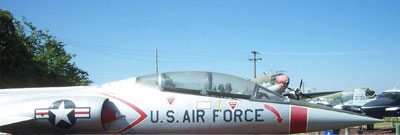 |
 |
|||
| A: To enable ejecting crew members to avoid the Starfighter's high-set tailplane, its designers initially made the disastrous decision to fit a downward-firing ejector seat! | B: Visibility from the Starfighter's cockpit was not great, but this did not hinder the interceptor role for which the aircraft was designed. | C: The half-cones in the center of each of the F-104's engine intakes were designed to improve the flow of air to the Starfighter's powerful engines. | D: Short range was a problem with the first Mach 2 jets. The F-104 quickly lost its wingtip missiles to make room for extra fuel tanks. |
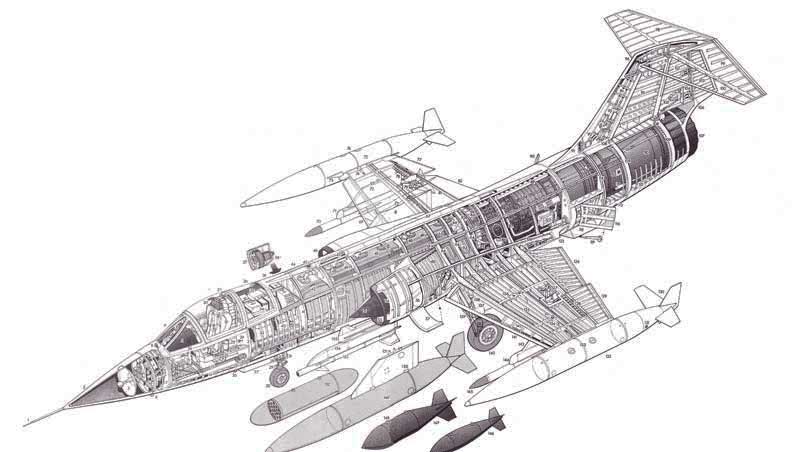 |
This F-104 cutaway comes in 4x8 size with in PDF included free in your MyModels folder! |
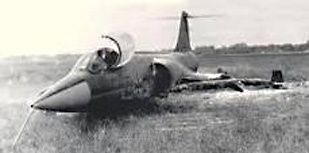 F-104 Starfighter crash. Looks like it was simply a slide-to-a-stop wheels up landing. Interesting how the wings, with their anhedral, act as a good buffer. (right) Chucky-Eager (sic) ejecting from a F104. We can't spell his name properly because its Copyrighted and they're threatening to sue if we do!! |
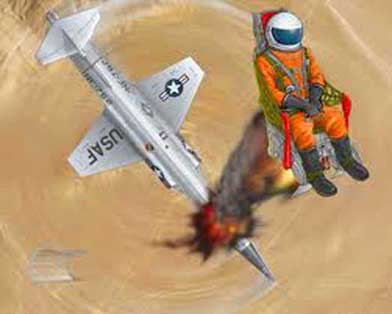 |
The poor safety record of the Starfighter brought the aircraft into the public eye, especially in Luftwaffe service. The subsequent Lockheed bribery scandals surrounding the original purchase contracts caused considerable political controversy in Europe and Japan.The poor safety record of the Starfighter brought the aircraft into the public eye, especially in Luftwaffe service. The subsequent Lockheed bribery scandals surrounding the original purchase contracts caused considerable political controversy in Europe and Japan. |
|
 |
|||
A: Original F-104s had a downward-firing ejector seat, a feature more usually found in Soviet jets. |
B: The area in front of the canopy was painted black to reduce glare for the pilot. |
C: The General Electric J79-GE-11A afterburning turbojet took up a lot of fuselage length |
D: The T-tail retained pitch control at transonic speed. This had been a problem in earlier designs flying close to the sound barrier. |
E:The tiny 22-ft wing was optimized for Mach 2 performance. The anhedral, or downward angle, gave a very high rate of roll. |
F: Supersonic flying required new cutting edge technoligy at the intakes |
G: 1 × 20 mm (0.79 in) M61 Vulcan gatling gun, 725 rounds |
H: The Starfighter was not originally designed to have radar, a decision that was soon changed. A simple range-only set was fitted. |
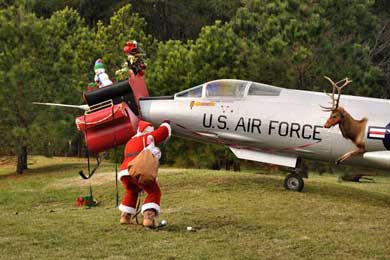 |
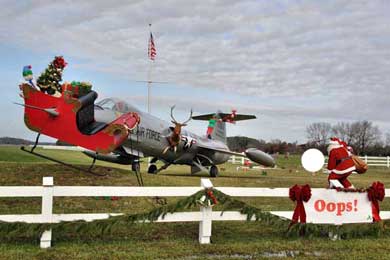 |
There's a guy in our general neighborhood who owns a bunch of planes, including an F-104 (and 3 Spitfires, etc.). He has a few bucks to play with and always comes up with an interesting and sometimes humorous display for Christmas, Hallowe'en, and so on. These 3 photos show what he did with his F-104 for Christmas 2011. It caused two weeks worth of slow traffic on Maryland Rte 33 from Easton to St. Michaels. I helped slow traffic by stopping my car to take some pictures too. An interesting diorama possibility for Christmas this year. Attribute the idea to Tom Blair, owner of the F-104....Cheers, Bill |
|


